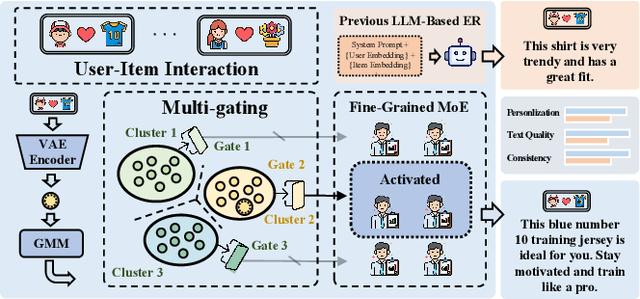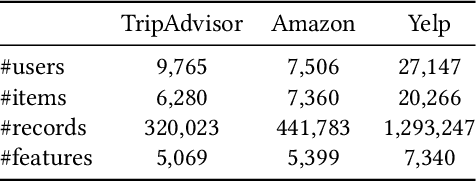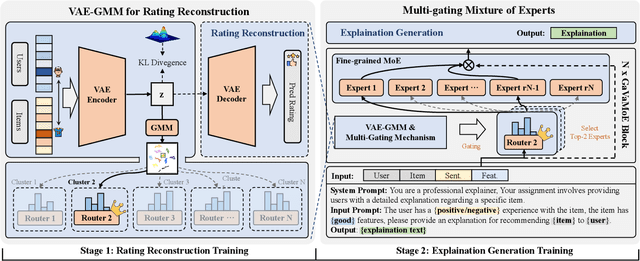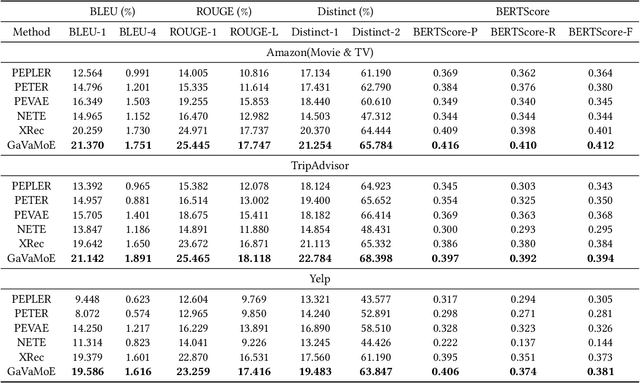Yongliang Shen
Embodied-Reasoner: Synergizing Visual Search, Reasoning, and Action for Embodied Interactive Tasks
Mar 27, 2025Abstract:Recent advances in deep thinking models have demonstrated remarkable reasoning capabilities on mathematical and coding tasks. However, their effectiveness in embodied domains which require continuous interaction with environments through image action interleaved trajectories remains largely -unexplored. We present Embodied Reasoner, a model that extends o1 style reasoning to interactive embodied search tasks. Unlike mathematical reasoning that relies primarily on logical deduction, embodied scenarios demand spatial understanding, temporal reasoning, and ongoing self-reflection based on interaction history. To address these challenges, we synthesize 9.3k coherent Observation-Thought-Action trajectories containing 64k interactive images and 90k diverse thinking processes (analysis, spatial reasoning, reflection, planning, and verification). We develop a three-stage training pipeline that progressively enhances the model's capabilities through imitation learning, self-exploration via rejection sampling, and self-correction through reflection tuning. The evaluation shows that our model significantly outperforms those advanced visual reasoning models, e.g., it exceeds OpenAI o1, o3-mini, and Claude-3.7 by +9\%, 24\%, and +13\%. Analysis reveals our model exhibits fewer repeated searches and logical inconsistencies, with particular advantages in complex long-horizon tasks. Real-world environments also show our superiority while exhibiting fewer repeated searches and logical inconsistency cases.
InftyThink: Breaking the Length Limits of Long-Context Reasoning in Large Language Models
Mar 09, 2025Abstract:Advanced reasoning in large language models has achieved remarkable performance on challenging tasks, but the prevailing long-context reasoning paradigm faces critical limitations: quadratic computational scaling with sequence length, reasoning constrained by maximum context boundaries, and performance degradation beyond pre-training context windows. Existing approaches primarily compress reasoning chains without addressing the fundamental scaling problem. To overcome these challenges, we introduce InftyThink, a paradigm that transforms monolithic reasoning into an iterative process with intermediate summarization. By interleaving short reasoning segments with concise progress summaries, our approach enables unbounded reasoning depth while maintaining bounded computational costs. This creates a characteristic sawtooth memory pattern that significantly reduces computational complexity compared to traditional approaches. Furthermore, we develop a methodology for reconstructing long-context reasoning datasets into our iterative format, transforming OpenR1-Math into 333K training instances. Experiments across multiple model architectures demonstrate that our approach reduces computational costs while improving performance, with Qwen2.5-Math-7B showing 3-13% improvements across MATH500, AIME24, and GPQA_diamond benchmarks. Our work challenges the assumed trade-off between reasoning depth and computational efficiency, providing a more scalable approach to complex reasoning without architectural modifications.
Think Twice, Click Once: Enhancing GUI Grounding via Fast and Slow Systems
Mar 09, 2025Abstract:Humans can flexibly switch between different modes of thinking based on task complexity: from rapid intuitive judgments to in-depth analytical understanding. However, current Graphical User Interface (GUI) grounding systems which locate interface elements based on natural language instructions rely solely on immediate prediction without reasoning, struggling to understand complex interface layouts with nested structures and hierarchical relationships, limiting their effectiveness on complex interfaces. Inspired by human dual-system cognition, we present Focus, a novel GUI grounding framework that combines fast prediction with systematic analysis. The framework dynamically switches between rapid and deliberate processing through an adaptive system switching based on task complexity, optimizing both efficiency and accuracy. Focus decomposes grounding into progressive stages: interface summarization, visual focused analysis, and precise coordinate prediction. This structured decomposition enables systematic understanding of both interface layouts and visual relationships. Extensive experiments show that Focus achieves state-of-the-art performance using only 300K of the training data with a 2B parameter model compared to existing approaches. Focus demonstrates superior performance particularly in complex GUI scenarios, achieving 77.4% average accuracy on ScreenSpot and 13.3% on the more challenging ScreenSpot-Pro. Our analysis reveals the effectiveness of this dual-system approach while demonstrating its potential for improving complex GUI interaction scenarios.
DB-Explore: Automated Database Exploration and Instruction Synthesis for Text-to-SQL
Mar 06, 2025Abstract:Recent text-to-SQL systems powered by large language models (LLMs) have demonstrated remarkable performance in translating natural language queries into SQL. However, these systems often struggle with complex database structures and domain-specific queries, as they primarily focus on enhancing logical reasoning and SQL syntax while overlooking the critical need for comprehensive database understanding. To address this limitation, we propose DB-Explore, a novel framework that systematically aligns LLMs with database knowledge through automated exploration and instruction synthesis. DB-Explore constructs database graphs to capture complex relational schemas, leverages GPT-4 to systematically mine structural patterns and semantic knowledge, and synthesizes instructions to distill this knowledge for efficient fine-tuning of LLMs. Our framework enables comprehensive database understanding through diverse sampling strategies and automated instruction generation, bridging the gap between database structures and language models. Experiments conducted on the SPIDER and BIRD benchmarks validate the effectiveness of DB-Explore, achieving an execution accuracy of 52.1% on BIRD and 84.0% on SPIDER. Notably, our open-source implementation, based on the Qwen2.5-coder-7B model, outperforms multiple GPT-4-driven text-to-SQL systems in comparative evaluations, and achieves near state-of-the-art performance with minimal computational cost.
AskToAct: Enhancing LLMs Tool Use via Self-Correcting Clarification
Mar 03, 2025Abstract:Large language models (LLMs) have demonstrated remarkable capabilities in tool learning. In real-world scenarios, user queries are often ambiguous and incomplete, requiring effective clarification. However, existing interactive clarification approaches face two critical limitations: reliance on manually constructed datasets and lack of error correction mechanisms during multi-turn clarification. We present AskToAct, which addresses these challenges by exploiting the structural mapping between queries and their tool invocation solutions. Our key insight is that tool parameters naturally represent explicit user intents. By systematically removing key parameters from queries while retaining them as ground truth, we enable automated construction of high-quality training data. We further enhance model robustness by fine-tuning on error-correction augmented data using selective masking mechanism, enabling dynamic error detection during clarification interactions. Comprehensive experiments demonstrate that AskToAct significantly outperforms existing approaches, achieving above 79% accuracy in recovering critical unspecified intents and enhancing clarification efficiency by an average of 48.34% while maintaining high accuracy in tool invocation. Our framework exhibits robust performance across varying complexity levels and successfully generalizes to entirely unseen APIs without additional training, achieving performance comparable to GPT-4 with substantially fewer computational resources.
STaR-SQL: Self-Taught Reasoner for Text-to-SQL
Feb 19, 2025Abstract:Generating step-by-step "chain-of-thought" rationales has proven effective for improving the performance of large language models on complex reasoning tasks. However, applying such techniques to structured tasks, such as text-to-SQL, remains largely unexplored. In this paper, we introduce Self-Taught Reasoner for text-to-SQL (STaR-SQL), a novel approach that reframes SQL query generation as a reasoning-driven process. Our method prompts the LLM to produce detailed reasoning steps for SQL queries and fine-tunes it on rationales that lead to correct outcomes. Unlike traditional methods, STaR-SQL dedicates additional test-time computation to reasoning, thereby positioning LLMs as spontaneous reasoners rather than mere prompt-based agents. To further scale the inference process, we incorporate an outcome-supervised reward model (ORM) as a verifier, which enhances SQL query accuracy. Experimental results on the challenging Spider benchmark demonstrate that STaR-SQL significantly improves text-to-SQL performance, achieving an execution accuracy of 86.6%. This surpasses a few-shot baseline by 31.6% and a baseline fine-tuned to predict answers directly by 18.0%. Additionally, STaR-SQL outperforms agent-like prompting methods that leverage more powerful yet closed-source models such as GPT-4. These findings underscore the potential of reasoning-augmented training for structured tasks and open the door to extending self-improving reasoning models to text-to-SQL generation and beyond.
MathFimer: Enhancing Mathematical Reasoning by Expanding Reasoning Steps through Fill-in-the-Middle Task
Feb 17, 2025Abstract:Mathematical reasoning represents a critical frontier in advancing large language models (LLMs). While step-by-step approaches have emerged as the dominant paradigm for mathematical problem-solving in LLMs, the quality of reasoning steps in training data fundamentally constrains the performance of the models. Recent studies has demonstrated that more detailed intermediate steps can enhance model performance, yet existing methods for step expansion either require more powerful external models or incur substantial computational costs. In this paper, we introduce MathFimer, a novel framework for mathematical reasoning step expansion inspired by the "Fill-in-the-middle" task from code completion. By decomposing solution chains into prefix-suffix pairs and training models to reconstruct missing intermediate steps, we develop a specialized model, MathFimer-7B, on our carefully curated NuminaMath-FIM dataset. We then apply these models to enhance existing mathematical reasoning datasets by inserting detailed intermediate steps into their solution chains, creating MathFimer-expanded versions. Through comprehensive experiments on multiple mathematical reasoning datasets, including MathInstruct, MetaMathQA and etc., we demonstrate that models trained on MathFimer-expanded data consistently outperform their counterparts trained on original data across various benchmarks such as GSM8K and MATH. Our approach offers a practical, scalable solution for enhancing mathematical reasoning capabilities in LLMs without relying on powerful external models or expensive inference procedures.
2.5 Years in Class: A Multimodal Textbook for Vision-Language Pretraining
Jan 03, 2025



Abstract:Compared to image-text pair data, interleaved corpora enable Vision-Language Models (VLMs) to understand the world more naturally like humans. However, such existing datasets are crawled from webpage, facing challenges like low knowledge density, loose image-text relations, and poor logical coherence between images. On the other hand, the internet hosts vast instructional videos (e.g., online geometry courses) that are widely used by humans to learn foundational subjects, yet these valuable resources remain underexplored in VLM training. In this paper, we introduce a high-quality \textbf{multimodal textbook} corpus with richer foundational knowledge for VLM pretraining. It collects over 2.5 years of instructional videos, totaling 22,000 class hours. We first use an LLM-proposed taxonomy to systematically gather instructional videos. Then we progressively extract and refine visual (keyframes), audio (ASR), and textual knowledge (OCR) from the videos, and organize as an image-text interleaved corpus based on temporal order. Compared to its counterparts, our video-centric textbook offers more coherent context, richer knowledge, and better image-text alignment. Experiments demonstrate its superb pretraining performance, particularly in knowledge- and reasoning-intensive tasks like ScienceQA and MathVista. Moreover, VLMs pre-trained on our textbook exhibit outstanding interleaved context awareness, leveraging visual and textual cues in their few-shot context for task solving~\footnote{Our code are available at \url{https://github.com/DAMO-NLP-SG/multimodal_textbook}}.
MAKIMA: Tuning-free Multi-Attribute Open-domain Video Editing via Mask-Guided Attention Modulation
Dec 28, 2024



Abstract:Diffusion-based text-to-image (T2I) models have demonstrated remarkable results in global video editing tasks. However, their focus is primarily on global video modifications, and achieving desired attribute-specific changes remains a challenging task, specifically in multi-attribute editing (MAE) in video. Contemporary video editing approaches either require extensive fine-tuning or rely on additional networks (such as ControlNet) for modeling multi-object appearances, yet they remain in their infancy, offering only coarse-grained MAE solutions. In this paper, we present MAKIMA, a tuning-free MAE framework built upon pretrained T2I models for open-domain video editing. Our approach preserves video structure and appearance information by incorporating attention maps and features from the inversion process during denoising. To facilitate precise editing of multiple attributes, we introduce mask-guided attention modulation, enhancing correlations between spatially corresponding tokens and suppressing cross-attribute interference in both self-attention and cross-attention layers. To balance video frame generation quality and efficiency, we implement consistent feature propagation, which generates frame sequences by editing keyframes and propagating their features throughout the sequence. Extensive experiments demonstrate that MAKIMA outperforms existing baselines in open-domain multi-attribute video editing tasks, achieving superior results in both editing accuracy and temporal consistency while maintaining computational efficiency.
GaVaMoE: Gaussian-Variational Gated Mixture of Experts for Explainable Recommendation
Oct 15, 2024



Abstract:Large language model-based explainable recommendation (LLM-based ER) systems show promise in generating human-like explanations for recommendations. However, they face challenges in modeling user-item collaborative preferences, personalizing explanations, and handling sparse user-item interactions. To address these issues, we propose GaVaMoE, a novel Gaussian-Variational Gated Mixture of Experts framework for explainable recommendation. GaVaMoE introduces two key components: (1) a rating reconstruction module that employs Variational Autoencoder (VAE) with a Gaussian Mixture Model (GMM) to capture complex user-item collaborative preferences, serving as a pre-trained multi-gating mechanism; and (2) a set of fine-grained expert models coupled with the multi-gating mechanism for generating highly personalized explanations. The VAE component models latent factors in user-item interactions, while the GMM clusters users with similar behaviors. Each cluster corresponds to a gate in the multi-gating mechanism, routing user-item pairs to appropriate expert models. This architecture enables GaVaMoE to generate tailored explanations for specific user types and preferences, mitigating data sparsity by leveraging user similarities. Extensive experiments on three real-world datasets demonstrate that GaVaMoE significantly outperforms existing methods in explanation quality, personalization, and consistency. Notably, GaVaMoE exhibits robust performance in scenarios with sparse user-item interactions, maintaining high-quality explanations even for users with limited historical data.
 Add to Chrome
Add to Chrome Add to Firefox
Add to Firefox Add to Edge
Add to Edge